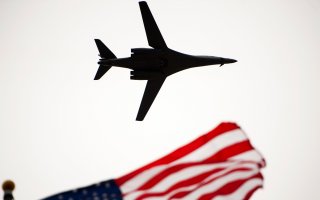Air Force Task Forces Showcase American Resolve Around the World
Strategic bombers send a message to friend and foe alike.
Here's What You Need to Know: Strategic bombers can assure allies and partners while deterring near-peer competitors.
Air Force B-1 bombers have gone to India and Norway as part of the service’s massively stepped-up Bomber Task Force (BTF) global operations, intended to further solidify international partnerships, interoperability and conduct high-impact deterrence missions intended to reassure U.S. allies amid ongoing threats posed by Russia and China.
Bomber Task Forces, a longstanding U.S. Air Force practice, are expanding in size, scope and frequency, often extending to less visited parts of the globe such as the Arctic and parts of Western Asia. These Task Forces often include B-1s, B-52 and B-2 to demonstrate force and resolve, particularly in high-threat contested areas such as the South China Sea area parts of Eastern Europe.
“I’m pleased with the way we have approached it to get to places around the globe and show presence for partners and allies. We have implemented leaner logistics and faster turn times and done some good experiments. We are working with our partners and allies and putting a lot of focus on the Pacific and Europe to give us more reach. We have the highest bomber aircrew readiness in the history of the command,” said General Timothy Ray, Air Force Global Strike Command Commander.
B-1 bombers in Norway introduce new patrol opportunities to show force and presence in the Arctic region which is increasingly contested by major power rivals. Competitors such as Russia and China are looking to expand influence, gather or harvest natural resources and, perhaps most of all, gain unparalleled strategic advantage by establishing a tactical footprint with quick access to virtually all parts of the Northern Hemisphere.
Also, places like the South China Sea in the Pacific may present new opportunities for smaller, shorter, more targeted and tactically relevant BTFs, particularly in and around island areas where China continues to increase operation.
“We are looking more aggressively beyond the current list of locations. Small scale short deployments give us different options,” Ray said.
Interestingly, Ray’s strategic emphasis is already taking to the sky, as the U.S. Central Command just sent two B-52H Stratofortress bombers flying through vital parts of the Middle East in what is seen as a warning message to Iran. It was the fourth bomber deployment into the Middle East already just this year.
“Multiple partner nations and U.S. Air Force fighter aircraft accompanied the U.S. bombers at different points during the flight, including Israel, Saudi Arabia and Qatar,” a statement from U.S. Central Command said.
As part of his discussion about Bomber Task Forces, Ray referred to the re-engineering of the B-52 as well as the addition of new radar and cruise missiles to the platform such as the emerging Air Launched Rapid Response (ARRW) hypersonic weapon.
“We have done some flight tests on ARRW and plan to do more tests later this year,” Ray added.
Precision targeting, a new generation of networking technologies and upgraded weapons systems also bring new opportunities for deterrence. For instance, bombers can now much more quickly and efficiently receive and integrate new threat data or intelligence information while in route. Point to point communications between ground command and control centers, ships, air assets and even nearby drones can operate in a dispersed, widely disaggregated way, yet still sustain high levels of secure connectivity. B-52 mission pilots, for example, don’t have to merely load target coordinates up into a database prior to flight but can also receive new ones in near real-time should intelligence change on the ground. Therefore, not only do potential adversaries know the precision-target devastation bombers could inflict in the event of war, but they are also increasingly aware that modern bombers can hold much larger areas at risk and overcome many standard enemy countermeasures.
Kris Osborn is the defense editor for the National Interest. Osborn previously served at the Pentagon as a Highly Qualified Expert with the Office of the Assistant Secretary of the Army—Acquisition, Logistics & Technology. Osborn has also worked as an anchor and on-air military specialist at national TV networks. He has appeared as a guest military expert on Fox News, MSNBC, The Military Channel, and The History Channel. He also has a Masters Degree in Comparative Literature from Columbia University.
This article first appeared in March 2021.
Image: U.S. Air Force photo/Senior Airman Scott Jackson

